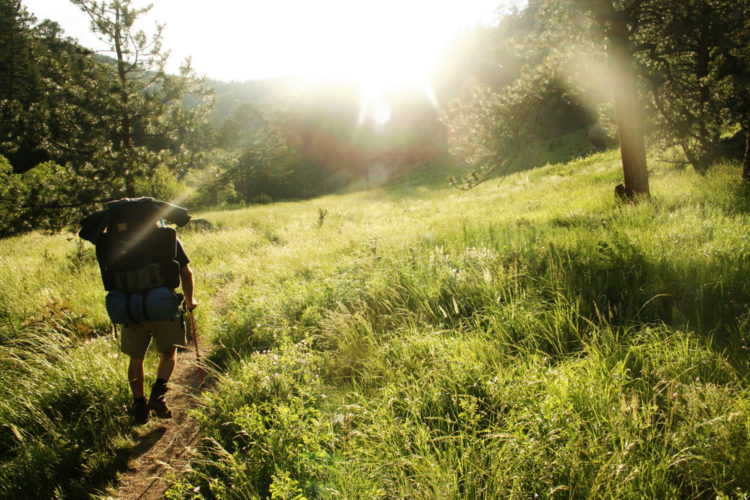On the cusp of getting my toes wet in backpacking — something I learned you don’t actually want to do should you go backpacking — I recently signed up for a free Backpacking Basics course at REI St. Louis. The two-hour class was attended by 30 enthusiastic future trailblazers and taught by the store’s own Jake Roux, a 10-year employee and experienced hiker who has trekked from the Great Sand Dunes National Park in Colorado to the top of Mount Herard in the Sangre de Christo range of the Rocky Mountains and beyond.
Overall, the class was definitely worth taking for this woodland newbie and cost me nothing but my time and attention. It was informative, fun, and easy to follow, and Roux did a great job teaching us by using his own experiences to demonstrate some important dos and don’ts of backcountry adventure. Here are a few of the tips and tidbits we walked away with:
There is no one-size-fits-all to backpacking.
Backpacking is less about the brand of equipment you bring along and more about the memories you make. If Roux wanted to get anything across to the class, it was that there is no one way to backpack. Each journey is as unique as the backpacker himself. Some people prefer hiking in woods while others prefer a rocky landscape, such as the Grand Canyon or a mountain summit. There are winter backpackers and summer ones, and those who enjoy both.
Pack lightly.
We’ve all heard the saying that less is more. This adage certainly applies to backpacking. Whether you hike for a few hours a day or all day long, you’ll be carrying your bag the entire time. So, to help reduce the weight of your pack, Roux suggests only taking essential items.
Food and shelter will be two of those items, so plan accordingly. As far as toiletries, think travel-sized and understand that you can probably go a day or two without washing off. Toilet paper can be taken off the roll and sealed in a plastic baggie. If you bring extra clothing, roll it to save space and only take the bare minimum.
Know your sleeping options.
When we think of camping in the woods, we often envision ourselves inside a tent tucked into our sleeping bag. That’s only one option. Roux prefers a hammock, which is lightweight and easy to set up between trees. For added protection from bugs and rain, prop a tarp over your hammock using hiking sticks or tent poles. (Some hammocks come with built-in bug nets or rain tarps.)
If you do choose to sleep in a bag, be sure to purchase one that fits your comfort level. Roux recommends trying it out in the store before you buy it. Make sure the bag matches your shape and size and that it is rated at least 10°F warmer than the temperatures you expect. A portable sleeping pad can also help. Again, make certain that the size is right and that you can roll or fold the pad for easy transport.
Leave no trace.
One of the most common reasons people get into backpacking is to experience the beauty nature has to offer us. There’s no worse way to disrespect nature than to leave behind trash or disrupt the natural surroundings. The only souvenirs a backpacker needs to take home are memories or photos. Leave nothing behind but your footprint.
Expect the unexpected.
One of the first rules in any outdoor activity is to practice safety. All backpackers should pack a first-aid kit and know how to use its contents in the event of a fall, cut, bite, or other injury. Be sure to bring along any required medications, but don’t overdo it. You probably don’t need to pack a flare gun or set of crutches.
Do, however, let someone not joining you on your adventure know where you are in case of an emergency. Some hikers have been lost to last-minute trips where they got turned around and no one knew they were missing until it was too late.
To avoid getting lost, study your trail maps and plan out an alternate route in case water or some other impassable obstacle blocks your way. Bring along a battery-powered GPS or compass.
Should you get lost, relax. Panicking does no good. One of Roux’s all-time favorite hikes involved him making an unexpected overnight stay on the Appalachian Trail. As he put it, the unexpected can lead to a better story.
Don’t feed the animals.
Sometimes the unexpected can present itself in the form of a hairy creature with sharp teeth and claws. Roux has encountered many woodland animals, including bears, but luckily he hasn’t had any bad experiences with them.
To minimize potential hazards, there are things you can do to avoid attracting wild animals. First, don’t leave your food on the ground overnight. Place it in an airtight bag and hang it up high over a tree branch. More likely to get into your food than a bear are raccoons, so hanging food or edible items up high is a good solution for both. You can also purchase bear spray or a whistle from any REI or similar store.
Back to School
REI St. Louis offers a full schedule of courses on backpacking, hiking, and camping (as well as biking, climbing, and other outdoor pursuits). Below is a list of some classes on the horizon:
-Gourmet Camp Cooking
-Overnight Backpacking
-Travel Light
-Ozark Highlands Camping
-Making the Ultimate Cup of Camp Coffee
-Elevated (Hammock) Camping
-Camp Stove and Water Filtration
Dates, locations, and fees vary. See rei.com/stores/st-louis.html for details.
Author: Heather Ervin is a contributor to Terrain magazine


[…] Backpacking Basics ‹ Terrain Magazine – Outdoor Fitness, Adventure & Discovery | St… […]